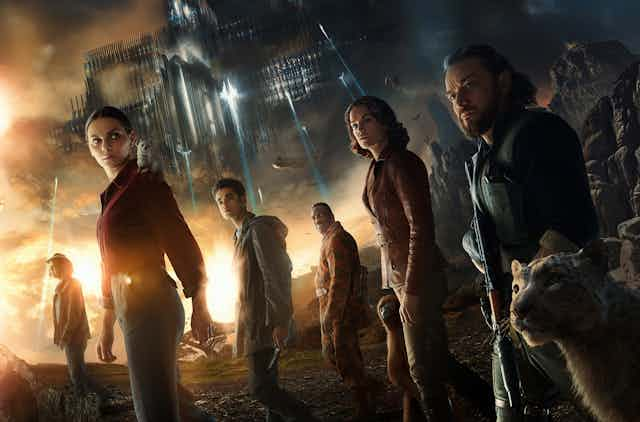In its concluding season, the BBC adaptation of His Dark Materials approaches a moment of danger. A story that began with the intimate world building of parallel Oxfords must now take on the fate of the entire multiverse.
Season three begins with our protagonist Lyra (Dafne Keen) lying in a stupor, drugged by her mother, Marisa Coulter (Ruth Wilson). She is in the eye of a storm of cosmic proportions, as the Magisterium (authoritarian representatives of a false divinity) try to track her down before her friend Will (Amir Wilson) can. And before her father, Lord Asriel (James McAvoy), incites a dimension-spanning revolution.
How will the small screen deal with the big ideas that come to the fore as we approach the cosmic showdown?
The problem stems from Philip Pullman’s decision to cast his trilogy as an epic.
Drawing on John Milton’s Paradise Lost, His Dark Materials pits brave, imaginative (and not always truthful) children against an oppressive religious establishment. One that wants to sever them from their souls in a bid to eliminate “dust” – a cosmic force associated with consciousness or, as the clerics would have it, original sin.
This story works as an allegory of Pullman’s guiding belief in the power of story to liberate the imagination from the shackles of dogma or ideology.
But it also embroils him in metaphysical squabbles that threaten to overburden the lightness and openness of the story. And this danger is greatest in the final instalment as these grand concepts move centre stage.
Visual storytelling
Pullman’s storytelling deals with this by foregrounding visual representation and cleaving to one of the founding principles of children’s literature criticism: show, don’t tell.
Before it is an idea, dust is a shimmer in Asriel’s magic lantern show, or the force that powers Lyra’s alethiometer (an exquisitely crafted brass instrument of symbols and dials that point to truth).
Pullman uses defamiliarisation, a technique that Russian Formalist critic Viktor Shklovsky described as unsettling our conventional perception by introducing us to objects from unfamiliar angles, without naming them.
He deposits us in an alternative, steampunk Oxford of “experimental theologians” and “anbaric power”, where everyone is accompanied by a “daemon”, as if we already knew what these things are.

They are, respectively, physicists, electricity and an externalised aspect of the soul that takes the form of an animal (usually of the opposite sex). But none of this is explained. We are left to piece together our own ideas of these things by inference.
The story is, however, committed to a climax in which the fate of the universe will be decided. And this also means that the meaning of dust is in the process of being fixed, potentially losing at least some of the constructive ambiguity that made it a gift to readerly freedom.
Challenges for the small screen
So how does the small screen deal with all of this? The first two series handled the visuals of Pullman’s world-building well, with nicely designed gadgets and decent effects. But they also depended on the spirited performances of Dafne Keen and Amir Wilson to carry some flat dialogue and sluggish editing.
These drawbacks did not seem to bode well for a narrative that must now carry us across universes, through battles and theological debates and even into the land of the dead.

On the whole, however, the new season thrives on its expanded canvas. This involves liberal use of aerial shots panning over mountain ranges and boundless plains, as handsomely done as the wildernesses through which another BBC star, Brian Cox, strides in his documentaries.
Occasionally, the action movie elements are a little brash. I’m not sure I was ready to see Asriel’s daemon co-piloting a light aircraft, barking: “We’ve lost the rear oscillator!”
There are some lengthy bouts of exposition in the bowels of the Magisterium, albeit enlivened by some nice gadgetry in the form of Father Gomez’s mechanical beetle drone.
But there are also moments of intimacy in the vastness of the landscape, as when Mrs Coulter picks up a deaf girl on a deserted beach and is briefly undone by her trusting embrace.
Epic migrations
The real triumph of the third series is the imagining of Will and Lyra’s journey towards the land of the dead.
We are led through a bewildering landscape of holding areas and waiting rooms – all washed-out grey-green tiles and backlit frosted windows – in which groups of dazed people queue, or mill, or sit.
The feel is by turns abandoned warehouse, nightmare bus station or migrant detention facility.

These scenes reminded me of an idea floated by the Indian novelist Amitav Ghosh in his literary response to climate change, The Great Derangement: that the epic genre may be better equipped than the realist novel to provide story forms equal to the scale of the coming emergency.
It may seem a strain to burden His Dark Materials with yet another big idea. But climate change has certainly been a growing concern for Pullman. And critics have started to pick up on its influence for his later forays into Lyra’s world, notably in Serpentine (2020). Jack Thorne, writer of the BBC adaptation, has likened Lyra to Greta Thunberg.
The TV adaptation certainly does not preach on the topic any more than Pullman’s novels did. But it plays its part in a more diffuse need to find ways of imagining a world in flux – a world on the edge.

